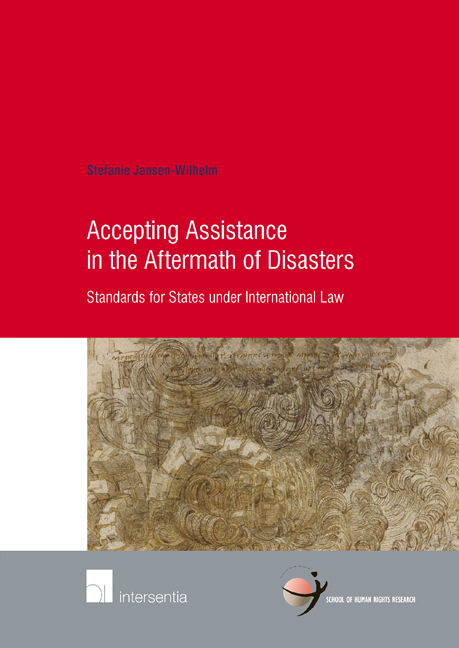Book contents
- Frontmatter
- Dedication
- Acknowledgements
- Contents
- List of Abbreviations
- Part I
- Chapter I General Introduction
- Chapter II Disaster Response and International Humanitarian Assistance: Background and Legal Framework
- Chapter III Practical Application of the Rules on International Humanitarian Assistance in Response to Disasters
- Preliminary Conclusions
- Part II
- Summary
- Bibliography
- Index
- Curriculum Vitae
- School of Human Rights Research Series
Chapter II - Disaster Response and International Humanitarian Assistance: Background and Legal Framework
from Part I
Published online by Cambridge University Press: 12 December 2017
- Frontmatter
- Dedication
- Acknowledgements
- Contents
- List of Abbreviations
- Part I
- Chapter I General Introduction
- Chapter II Disaster Response and International Humanitarian Assistance: Background and Legal Framework
- Chapter III Practical Application of the Rules on International Humanitarian Assistance in Response to Disasters
- Preliminary Conclusions
- Part II
- Summary
- Bibliography
- Index
- Curriculum Vitae
- School of Human Rights Research Series
Summary
INTRODUCTION
Various attempts have been made to create more clarity in the rules and principles that apply in disaster situations. However, the international legal developments of the last century
Are all at the periphery of the issue. At the core is a yawning gap. There is no definitive, broadly accepted source of international law which spells out the legal standards, procedures, rights and duties pertaining to disaster response and assistance. No systematic attempt has been made to pull together the disparate threads of existing law, to formalize customary law or to expand and develop the law in new ways.
Although there is no coherent system, this Chapter will look into the rules and principles that can be derived from legal sources. These sources consist of general international law that is relevant for the topic of humanitarian assistance as disaster response, and of sources that were developed especially for this topic.
Before going into the legal framework, a number of developments will be discussed that proved determining factors for the way international humanitarian assistance is perceived today. Over the centuries, different views have existed on what the role of international humanitarian assistance should be when a natural disaster struck. A number of these views were put into practice in setting up special organisations or attempts at codifying principles of disaster response. These developments will illustrate what have been successful or – in most cases – less successful approaches to international disaster response and humanitarian assistance. Moreover, keeping the past attempts in mind, it is possible to explain where certain rules and principles come from and to understand why certain developments and attempts at codification will (potentially) be successful or likely to fail.
THE FIELD OF INTERNATIONAL DISASTER RESPONSE: BACKGROUND AND MAIN ACTORS
Introduction
Until roughly the end of the nineteenth Century and the beginning of the twentieth Century, the ideas on international disaster response, and more specifically the delivery of international humanitarian relief, developed along a more or less singular line of thought.
- Type
- Chapter
- Information
- Accepting Assistance in the Aftermath of DisastersStandards for States under International Law, pp. 23 - 76Publisher: IntersentiaPrint publication year: 2015



